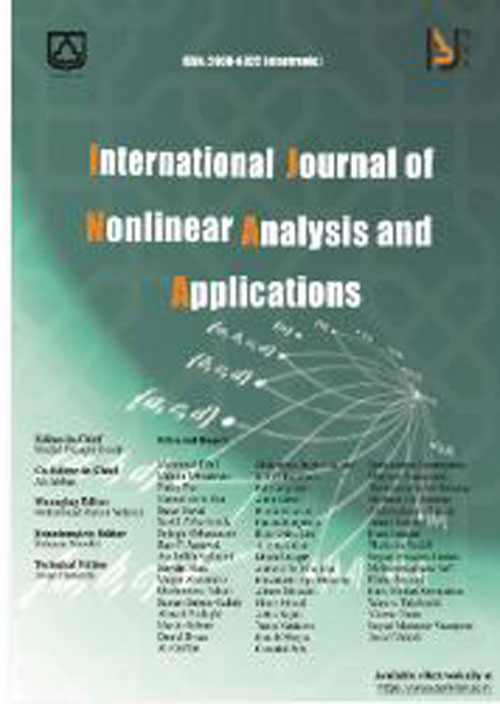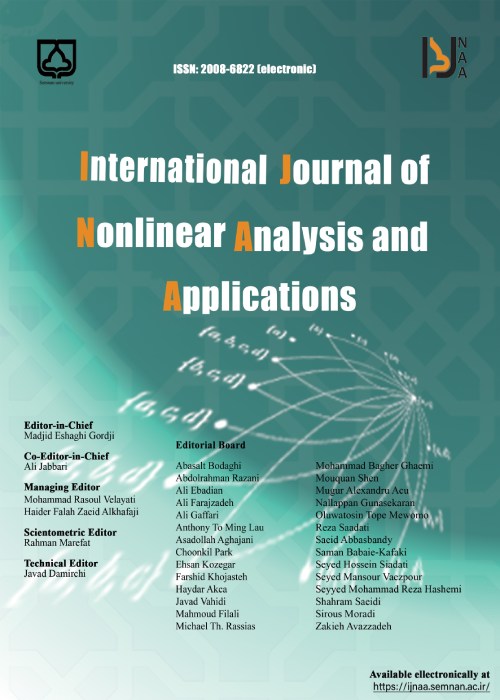فهرست مطالب

International Journal Of Nonlinear Analysis And Applications
Volume:13 Issue: 1, Winter-Spring 2022
- Special Issue
- تاریخ انتشار: 1401/05/18
- تعداد عناوین: 16
-
-
Pages 1-15
In this chapter, we investigate the global attractivity of the recursive sequence ${mathcal{U}_n} subset mathcal{P}(N)$ defined by[mathcal{U}_{n+k} = mathcal{Q} + frac{1}{k} sum_{j=0}^{k-1} mathcal{A}^* psi(mathcal{U}_{n+j}) mathcal{A}, n=1,2,3ldots,]where $mathcal{P}(N)$ is the set of $N times N$ Hermitian positive definite matrices, $k$ is a positive integer,$mathcal{Q}$ is an $N times N$ Hermitian positive semidefinite matrix, $mathcal{A}$ is an $N times N$ nonsingular matrix, $mathcal{A}^*$ is the conjugate transpose of $mathcal{A}$ and $psi : mathcal{P}(N) to mathcal{P}(N)$ is a continuous. For this, we first introduce $mathcal{FG}$-Prev{s}i'c contraction condition for $f: mathcal{X}^k to mathcal{X}$ in metric spaces and study the convergence of the sequence ${x_n}$ defined by[x_{n+k} = f(x_n, x_{n+1}, ldots, x_{n+k-1}), n = 1, 2, ldots]with the initial values $x_1,ldots, x_k in mathcal{X}$. We furnish our results with some examples throughout the chapter. Finally, we apply these results to obtain matrix difference equations followed by numerical experiments.
* The formulas are not displayed correctly
Keywords: fixed point approximation, iterative method, matrix difference equation, equilibrium point, global attractivity -
Pages 17-29
In this work, we prove the existence of the solution of integral equations via fixed point results in the framework of extended Branciari $b$-distance spaces. In order to do this, we introduce ${FG}$-contractive conditions in extended Branciari $b$-distance spaces and derive common fixed points results for triangular $alpha$-admissible mappings, followed by some suitable examples.
* The formulas are not displayed correctlyKeywords: Fixed point, extended Branciari $b$-distance spaces, triangular $alpha$-admissible mappings, integral equations -
Pages 31-42
The main motive of this paper is to discuss coupled coincidence points in the setting of the newly established concept $Y$-cone metric spaces. We obtain coupled coincidence point theorems through mixed monotone mappings in ordered $Y$-cone metric spaces. We give an illustrative example, which constitutes the main theorem.
* The formulas are not displayed correctlyKeywords: coupled common fixed point, mixed g-monotone maps, $Y$-cone metric space -
Pages 43-52In this article, we redefine the single-valued neutrosophic composite relation and apply it to medical diagnosis. We also show that the redefined neutrosophic composite relation gives a better result.Keywords: Single valued neutrosophic set, Single valued neutrosophic relation, Single valued neutrosophic composite relation, Neutrosophic medical diagnosis
-
Pages 53-60Digital currency plays a vital role in the process of trading as it helps the sellers and buyers to earn more profit. In today’s world, many categories of cryptocurrencies exist and each one of them employs its own security algorithms. Bitcoin price prediction is a complex problem that needs advanced algorithms to solve exactly. In this paper, swarm-based intelligence algorithms are applied in order to solve the bitcoin value prediction problem. In particular, Ant Colony Optimization and Binary Grasshopper Optimization algorithms are combined as a hybrid framework to select the most critical features in the dataset for bitcoin value prediction. The extracted features from the hybrid model are given as input to the convolutional neural network to predict the price of the bitcoins. As per the experimental results, the proposed hybrid algorithm produces better results when compared with the stand-alone version of grasshopper and neural network algorithms.Keywords: Bitcoin, Value Prediction, Optimization Algorithm, Binary Grasshopper Algorithm, CNN Algorithm
-
Pages 61-69Each and every human have unique fingernails. In the early days, the psychological conditions of the human body were reflected with the help of the growth situation of the surface of nails. It is possible to diagnose human nails and predict the disease. Predicting the disease at the early stage helps in preventing the disease. In this proposed work, the image of the nail is taken from a microscopic image. The lunula and nail plate are segmented effectively using the image pre-processing techniques. Histograms of oriented gradients and local binary patterns are used to capture the characteristic value. Once after pre-processing various features of the nails are extracted using various machine learning algorithms such as Support Vector Machines, Multiclass Support Vector Machine, Convolution Neural Network along with an Optimization algorithm named Ant Colony Optimization to improve the efficiency of classification.Keywords: Local binary pattern (LBP), Block Chain Technology (BCT), Machine Learning (ML)
-
Pages 71-76
Fruit Categorization is a classification problem that the agricultural fruit industry needs to solve in order to reduce the post-harvesting losses that occur during the traditional system of manual grading. Fruit grading which involves categorization is an important step in obtaining high fruit quality and market demand. There are various feature selection challenges in agriculture produced especially fruit grading to build an appropriate machine learning approach to solve the problem of reducing losses. In this paper, we describe different features, a machine learning technique that has been recently applied to different fruit classification problems producing a promising result. We discuss the feature extraction method, technique used in image classification applications for fruit prediction. A proposed multiclass fruit classification model is theoretically described and their most distinguishing features and technique is then presented at the end of this paper.
Keywords: Fruit Classification, Feature Fusion, feature extraction, Multiclass SVM -
Pages 77-87The objective of this paper is to demonstrate the results of coupled fixed point that possesses the property of mixed monotone involving altering distance functions in the framework of partially ordered metric spaces. To illustrate our results, we provide an example.Keywords: Coupled fixed point, partial ordered, Complete metric space
-
Pages 89-95Edge detection is a digital image processing technique to find the boundaries or edges of an image or object through brightness discontinuity. There are many operators to get boundaries or edges but we need more effective and accurate methods. This paper will provide a comparison of hybrid techniques that combine second-order derivative techniques Log and Canny, With Conventional Sobel, Prewitt, Roberts, Canny and Log Operators Edge Detector Techniques With regard to visual inspection, Mean Square Error (MSE), Root Mean Square Error (RMSE), signal to noise ratio (SNR), peak signal to noise ratio (PSNR), mean-absolute error (MAE) and Bit error, etc.Keywords: Hybrid technique, Sobel operator, Prewitt operator, Roberts operator, canny operator, log operator, Edge detection, mean square error (MSE), Root mean square error (RMSE), mean absolute error (MAE), signal to noise ratio(SNR), Peak Signal to noise ratio (PSNR), Bit error
-
Pages 97-108
In this article, we introduce the notion of $F_n$-contractions $T:A^nrightarrow B$ in standard metric spaces and explore the possibility of certain approximation results for these mappings. We prove the existence and uniqueness of $n$-tuple ($n geq 2$) best proximity points of $F_n$-contractions, not necessarily continuous, using the weak $P$-property in complete metric spaces. Additionally, suitable examples are presented to substantiate our main results. Moreover, we anticipate a fixed point result to prove the existence and uniqueness of the solution for a type of integral equation to elucidate our obtained theorems.
* The formulas are not displayed correctlyKeywords: $F, n$-contractions, best proximity points, $P$-property, weak $P$-property, $n$-tuple best proximity points -
Pages 109-116
We study certain things connecting strong bi-ideals of bi-near subtraction semigroup in a sub commutative $S$-bi-near subtraction semigroup. A bi-ideals $B$ of $X$ is strong bi-ideals if $X_1B_1^2subseteq B_1$ (or $X_2B_2^2subseteq B_2$) denotes $XB^2subseteq B$.
* The formulas are not displayed correctlyKeywords: $S$-bi-near subtraction semigroup, sub commutative, bi-ideals -
Pages 117-125The reduction of the noise of the images always prevails as a challenge in the field of image processing. An image obtained after the elimination of noise has a higher clarity in terms of interpretation and study analysis in different fields such as medical, satellite and radar. This research work examines the various methods of de-noise images in the spatial domain and a comparison between several filtering techniques is carried out in the presence of different types of noise to achieve a high-quality image and to find the most suitable and reliable method for De-noising images. performance of all the filters is compared using parameters such as Mean Square Error (MSE), peak signal to noise ratio (PSNR).Keywords: Image processing, Noise Removal, filtering techniques, mean square error (MSE), signal to noise ratio(SNR), Peak Signal noise ratio(PSNR)
-
Pages 127-132
We introduce weak $B$-bi-regular in bi-near subtraction semigroup and obtain properties of the same in a certain class of bi-near subtraction semigroup of $X$.
* The formulas are not displayed correctlyKeywords: weak $B$-bi-regular, $B$-bi-regular, bi-regular, $bar{S}$-bi-near subtraction semigroup, left (right) X-bi-algebra -
Pages 133-145In this article, Ulam Hyers stability of Volterra Fredholm (VF) type fractional integro-differential equation is studied by the fixed point notion in the generalized metric space. In addition, the efficiency of the Laplace decomposition method in the context of solving some integral equations of the Volterra Fredholm type is shown. Further convergence analysis of the numerical scheme is shown.Keywords: Fixed point, Ulam Hyers stability, metric space
-
Pages 147-155
The piston is thought to be a standout amongst the most essential parts in a reciprocating engine, reciprocating pumps, gas blowers and pneumatic barrels, among other comparable mechanisms. As most critical part, is that less time is required to outline the cylinder and simply a couple of essential details of the engine. Actually, due to high heat transfer through the piston, the outer shape of the piston crown will be deformed. So due to this problem here computational testing has been performed on ANSYS simulation software with three different materials and observed that stress of piston with ALSI AI alloy has maximum stress of $50.79 Mpa$ piston made of M-124 cast AL composite stress value is $50.54 Mpa$. Furthermore, maximum stress on M-124 forged AL alloy is found to be $50.23 Mpa$ and here observe that in case of deformation, piston made of ALSI AI alloy found to have maximum deformation of $1.06 mm$ and when piston made of M-124 cast AL combination then maximum deformation is $0.88 mm$. What's more, maximum deformation on M-124 forged AL alloy is found to be $0.086 mm$ and here observe that in case of heat flux, piston made of ALSI AI alloy is found to have maximum heat transfer of $3.3 w/mm^2$ is observed. When piston made of M-124 cast AL combination then maximum heat transfer of $3.4 w//mm^2$ and maximum heat flux on M-124 forged AL alloy is found to be $3.6 w/mm^2$. So the aluminium alloy M-124 is the best manufactured composite material So this material is suggested for manufacturing work.
* The formulas are not displayed correctly
Keywords: reciprocating engine, Thermal Analysis, Wheeler Piston -
Pages 157-163In this paper, we review some research works on exploring image processing in digital spaces using fixed point theorems. The basic concepts of digital images are mentioned. Moreover, we prove some theorems on digital metric spaces by replacing the conditions in the previously established theorem with a suitable condition.Keywords: fixed point theorems, Banach contraction principle, Digital images, digital contraction, digital metric space


